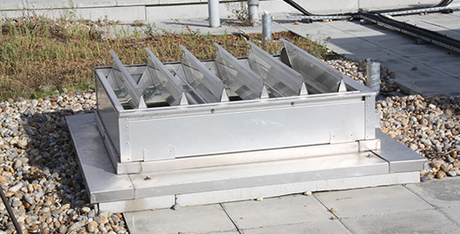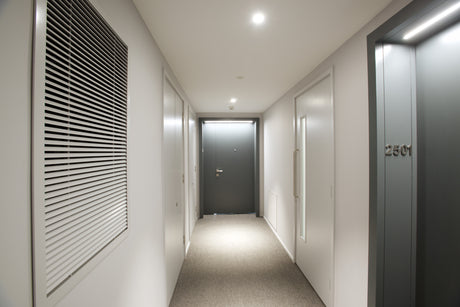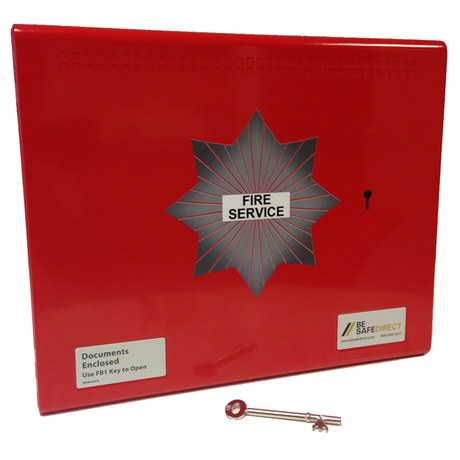A Smoke control system must be designed to maintain tenability within a building's egress path. This extends to the installation and maintenance of the components that form the smoke ventilation system.
Smoke control dampers are an integral part of most smoke venting systems, to which, it's crucial to understand the regulations that guide them and the importance of choosing a compliant product before making your selection. The use of non-certified products can compromise the integrity of the smoke ventilation system and compartmentation, thus causing increased risk to the building and its occupants.
Firstly, it's important to understand the differences between a smoke control damper and a fire damper.
What is a Smoke Control Damper?
A smoke control damper is defined as a damper that is certified to vent smoke through and is primarily used in smoke control systems serving multi-story buildings for both domestic and commercial smoke extraction shafts.
They are mechanical or intumescent devices placed within a duct or ventilation opening, which have louvres or shutters. Upon receiving a signal via the smoke and fire detection system, these shutters can close automatically, preventing the passage of smoke and other products of combustion.
How does a Smoke Control Damper work?
Let's take a closer look at a smoke control damper's intended purpose:
- A fire starts in a room
- As smoke spreads, the smoke sensor is triggered, activating the smoke ventilation system and smoke control damper
- Once activated, the blades on the damper on the affected floor move to an open position allowing smoke to be extracted up into the shaft; all other smoke dampers remain shut. For mechanical systems, smoke is extracted into the shaft via a fan on the roof. Natural systems utilise natural airflow dynamics to remove the smoke.
- The smoke is then passed up through the shaft and out through the roof, leaving the affected area free of smoke, aiding the occupant's means of escape, and providing suitable access for firefighting services
The Compliance Surrounding Smoke Control Dampers
There have been several key legislation and guidance documents relating to smoke control dampers. However, the most recently recognised is from the Smoke Control Association Guidance: Smoke Control to Common Escape Routes in Apartment Buildings (Flats and Maisonettes), which states on page 34:
"The vent, as described in ADB has to serve two functions. Firstly, it must be capable of venting heat and smoke into the shaft from the fire level; secondly, ?vents? on other levels away from the fire must remain closed and maintain fire separation on the other levels to prevent fire and smoke from spreading to the non-fire-affected levels. The only product designed, tested and certified to perform both these functions is a multi-compartment smoke control damper CE marked to EN 12101-8 refer to section 8.2."
It also mentions on page 56 - 8.2.2.1 Multi-compartment smoke control damper's that:
"Smoke control dampers used should, as a minimum, be classified to BS EN 12101-8 as multi-compartment smoke control dampers."
Approved Document B parts 1 and 2 and BS 9999:2017 both enforce this recommendation. Most recently, this was supported by the freshly drafted version of BS 9991, which stated:
"AOVs opening into shafts or ducts should be smoke control dampers - Smoke control dampers should conform to BS EN 12101-8..."
Where can I buy a BS 12101-8 certified Smoke Control Damper?
Now that you have a better understanding of smoke control dampers and their required compliance, why not check out some of our BS 12101-8 certified smoke control damper products.
What is a Fire Damper?
Fire dampers are intended to allow air to flow through in normal operation. However, in the event of a fire, fire dampers are designed to automatically close, stopping the spread of fire through ducts, walls, floors, and ceilings and thus maintaining compartmentation. With regards to compliance, fire dampers used in building ventilation ducts should be:
- CE marked to BS EN 15650:2010 Ventilation for buildings ? Fire dampers.
- Tested to BS EN 1366-2 Fire resistance tests for service installations ? Fire dampers.
- Classified to BS EN 13501-3 Fire classification of construction products and building elements Part 3.
We also offer a range of fully compliant Fire Dampers.












